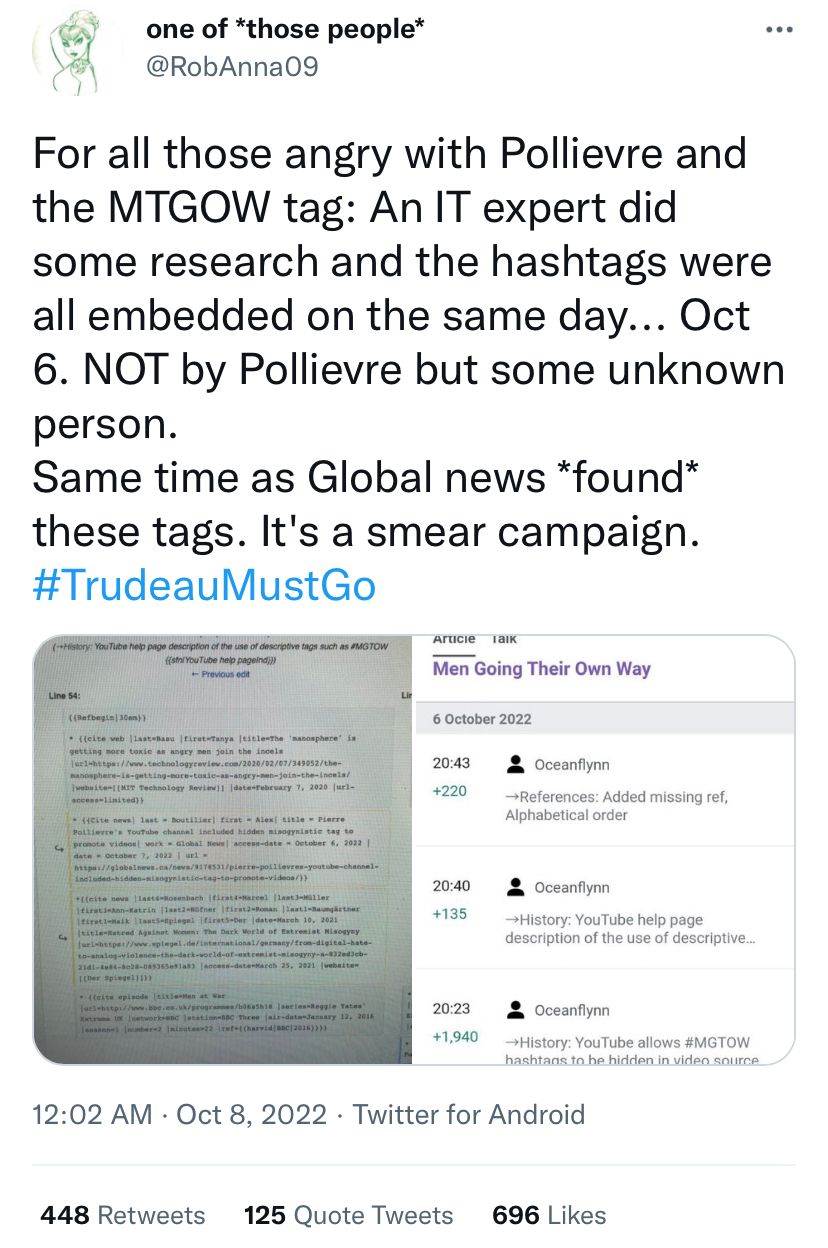If you haven't read my original story on Pierre Poilievre's bad YouTube tags, please do so first.

Since some people seem determined to keep this story alive (including the Prime Minister himself), I've decided to write another post on the subject of Pierre Poilievre's bad YouTube tags. After all, data archiving and data scraping really scratch an itch for me, so why not.
If Pierre Poilievre and his peeps this is going to go away. Think again.
— Catherine McKenna (@cathmckenna) October 6, 2022
In my original story, I used a one-line script to extract the tags on the live versions of all of Pierre Poilievre's YouTube videos. These are the tags as they existed after being (mostly) scrubbed of the offensive "MGTOW" tags.
Based on the information available from this process, I came to the following conclusions:
- The tags are set automatically from a list by whatever software his team uses to upload videos
- The "MGTOW" tag was first added to this list of tags in early 2018 (or earlier)
- Until the Global News story dropped, this list of tags hadn't been touched since early 2018
An interesting suggestion by Brett Byers got me thinking again about the source of the "MGTOW" tag.
Just a hunch as a comms guy, but I strongly suspect this was a consequence of hiring somebody be to create an “optimized” list of tags which includes dozens of tags that Poilievre’s team and the hired party alike were unaware of. A pretty normal practice for Google Ads too. https://t.co/wU7iTo2jXN
— Brett Byers (@Brett__Byers) October 6, 2022
Using the Wayback Machine, which allows you to see archived versions of webpages as they existed at an earlier time, I realized that tags related to conservative commentator Ben Shapiro had also been scrubbed from Poilievre's YouTube videos. However, based on a cursory inspection of the archived versions of a few old videos (preserving the original tags), that seemed to be it. The "MGTOW" tag stood out from the rest of the tags, which were all bog-standard political tags (with the exception of the "growth hacky" Shapiro tags).
But I realized with a little more scripting work, I could check for sure. So I wrote a script to extract the tags from the original, archived versions of every one of Pierre Poilievre's YouTube videos. This took more than one line of code, but was surprisingly easy thanks to the Wayback Machine API.
A few videos were missing from the Wayback Machine, but the vast majority (86%) were available so that I could extract the tags they had at the time the video was uploaded. You can find the dataset of all of the videos with their original, unaltered tags here (missing data are denoted with "NA").
The first video to use the "MGTOW" tag was uploaded on February 27, 2018. In fact, this is the same video I identified in my first post as still having the "MGTOW" tag at time of writing (I assumed they missed it when scrubbing the tag). I checked again and they have since removed the tag from this video. They also removed the stray "Ben Shapiro" tag I identified on another video. Did someone in Poilievre's office read my last post?
✅ Confirmed: The "MGTOW" tag was first added in early 2018
The next question: was there evidence of any further experimentation with "optimized" or "growth hack" tags?
No. Besides "MGTOW" and "Ben Shapiro", there were no other odd or out-of-place tags from this time period.
The characteristic mix of "MGTOW" and "Ben Shapiro" tags first appears in a video from March 2, 2018. The exact same tags are then used in almost every single video up to November 20, 2019 (note that dates in this post may be a day off due to time zone differences). Curiously, this last video is missing both tags related to "MGTOW" and "Ben Shapiro" and a few other videos in between these two dates are missing one or both of these tags.
After November 20, 2019, this characteristic set of tags is used identically in every video up to October 3, 2022, when Poilievre's team learned of the story.
❗Updated: The list of tags used in videos (which included both "MGTOW" and "Ben Shapiro") was mostly untouched from March 2018 to November 2019 and completely untouched from December 2019 to October 2022
This doesn't change much in my assessment except that there was a handful of instances prior to between 2018 and 2019 where someone fiddled with the Shapiro/MGTOW tags. Perhaps someone with better sense was responsible for uploading those videos and deleted the out-of-place tags from the end of the list. Who knows.
Only a few hours after Global News dropped their story, the Conservative Party called off their probe into the tags. Of course, at this point, no one knew that they had ever called on a probe.
“(Poilievre) has confirmed with current staff who were working with his office in 2018 that they did not add the tag. [...] “According to Youtube records, the tag in question was added in early 2018 and it has remained there since that time. Because Mr. Poilievre has had many staff upload videos who have passwords over the years, including in 2018, his office is unable to determine who exactly added the tag.”
To editorialize on this story for a moment, my guess is that Poilievre's team has a pretty good idea who added the tags. After all, how many people really managed his YouTube account in early 2018? Could Poilievre have directed his social media team to deliberately target the "MGTOW" community? Possibly, but I doubt it. More likely this was an initiative by an edgy, misguided staffer or an aborted attempt at "growth hacking" by latching on to popular tags. In either case, it's an unforced error by a politician with a reputation for being social media savvy and Poilievre did the right thing by promptly condemning the movement.
All in all, it's a pretty esoteric story, catnip to extremely online Twitter addicts such as myself but unlikely to gain much traction with the general public. But we'll see. Somewhat more entertaining is the conspiracy theories popping up such as the one from the gentleman below, who has apparently mistaken someone editing a Wikipedia page for surreptitiously adding tags to someone else's YouTube videos...

I hope I've done a service by digging up and providing as much valid information on the topic as possible. Feel free to draw your own conclusions from here.
If you learned something from this post, please consider subscribing for more data-informed storytelling using the button at the bottom right of the page.
All code and data used to write this post is available on GitHub.





